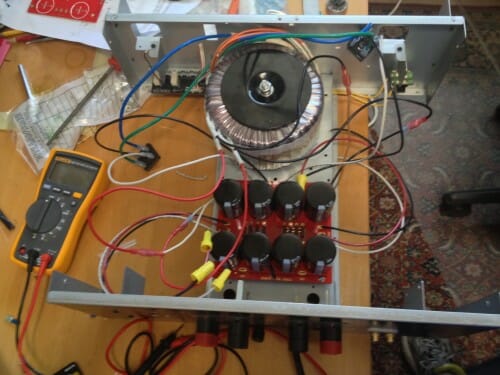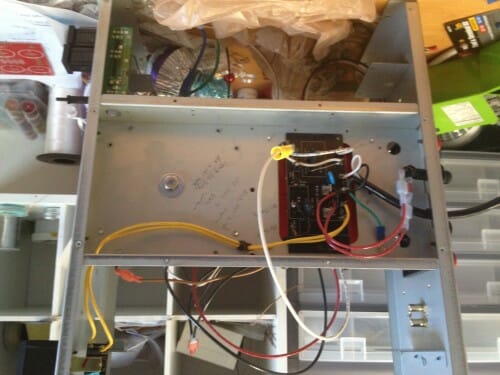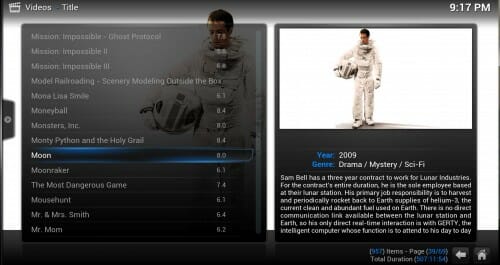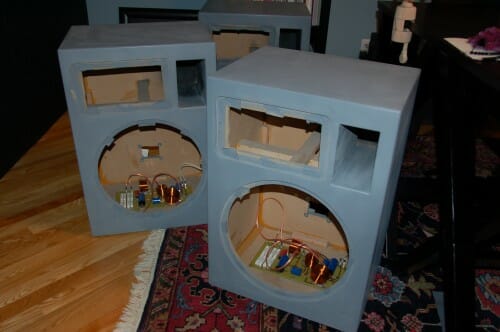I really enjoyed my first foray into building speakers (the first ones were here, and were an L-C-R for the home theater). So I tried building a new pair.

The home theater speakers are behind the projection screen (the big gray thing in the picture). The speakers definitely lose something behind the screen. Though it is no big deal on movies, for music I wanted speakers outside the screen. I needed something with high WAF (a term very common on audio discussion boards, it stands for wife acceptance factor) but that sounded good. In effect, I needed something relatively small that filled a big room.
These are bipolar speakers, which does not mean they are good at playing Rage Against the Machine albums. It means they have two drivers, usually at 180 degrees from each other. The advantage if well designed can be more full, room-filling sound. These have the second driver mounted on top, rather than in back. The reason for this is that I knew they would be close to the wall, and bipoles with rear-mounted drivers need space I did not have. I built them roughly to this design, though I used MarkAudio Alpair 7.3 drivers instead of those in the design, and I moved the port to the front from the bottom.
These are full range driver speakers. The driver actually runs from about 60-ish Hz to over 20,000 Hz and is pretty dang flat over that range. The advantage of this is we get rid of the electronic crossovers between the woofer, mid, and tweeter. Often the crossover frequencies sit right in the most sensitive range of the ear, as well as in vocal range, such that even small irregularities degrade the sound. Also, the sound is coming from a single point source, which sounds great, and the speaker is more efficient. The downside, of course, is that it is asking a lot of a driver to cover this wide range.
These speakers sound amazing (I will spare you the audio review-speak that sound so eerily similar to wine-snob-speak). You would simply not believe the sound that comes out of these little drivers. The bass is pretty solid too, though I think I will add a subwoofer on the bottom. The bass reinforcement comes from the quarter-wavelength transmission line design, the theory of which is discussed in great depth here. You can find a lot of this sort of design in stores, as the tall thin tower look is aesthetically appealing, and has the fortunate side effect of working well for bass reinforcement (probably the number one role of any cabinet). I spent a lot of time in Mathcad on these. I am starting to reach my goal of eventually building speakers of my own design -- for these I modeled and then modified an existing design.
The boxes are built out of 3/4-inch baltic birch plywood, again with all large saw cutting done by the lumber yard, while I did the rest at home. This is my first experience with veneer, which i in this case is black-dyed ash and it came out great, though I put the satin polyurethane coating on a bit too think and got them a bit glossier than I wanted. They are well braced on the inside and the back is removable to tune them with more or less fiber stuffing -- at first I only had a bit and the bass was too boomy, but adding more along the length of the speaker tightened the bass as well as the mids a bit.
This was a very easy project, much easier than the first speakers I built. As I learned the first time, with router jibs, round holes are actually easier than square ones. If someone is looking for a great starter project, these speakers, with just one driver, would be my choice. Markaudio is a great driver manufacturer, not only because they are making what may be the best full-range drivers out there, but their proprietor spends a ton of time on the boards interacting with the DIY community to find out what they would like to see changed.





